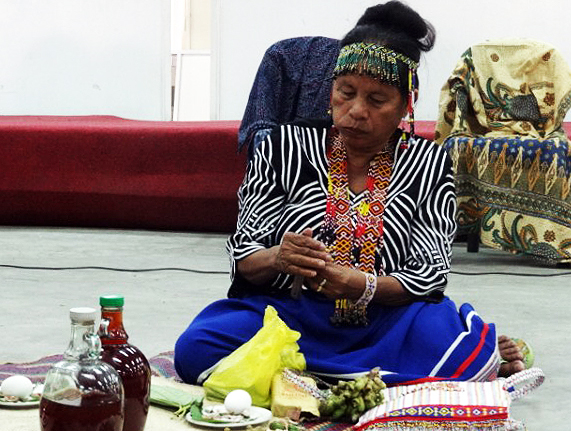Filtered by: Lifestyle
Lifestyle
Brief encounter with a Manobo babaylan
Text and photos by IME MORALES

Baylan Undin chews nganga (betel nut) while preparing the offerings.
From the mountains of La Paz, Agusan del Sur, Lordina “Undin” Potenciano left her home at 6 a.m. to start her journey. She traveled with her companions, including niece Robilyn Coguit Canto and her very young child. After trekking for almost 20 hours, part of which was spent riding motorcycles in the rain, they reached their destination at midnight. From there, they waited for the flight that would bring them to Manila for the Buhay Babaylan lecture-ritual event at UP Diliman last Saturday.
Undin is a Manobo babaylan who was called to baylanhood by spirits. As such, Baylan Undin is tasked to heal the sick and help those in need, and to officiate during rituals, where spirits chant and dance through her. For the first time, she came to Manila to be with musician Grace Nono as Grace gave a talk on the Voice of the Babaylan. As a scholar who specializes in the performance of Philippine oral chants and the documentation of oral traditions, Grace Nono counts Baylan Undin as one of her chant teachers.
A babaylan and her abyan
Babaylan is a term that refers to a person, usually female, whose functions include the following: ritual expert, healer, culture-bearer, and community religious leader. A babaylan is given the gifts of healing, foretelling and insight, and uses her extensive theoretical and practical knowledge of nature and people to extend help to those in need.
Robilyn, Baylan Undin’s interpreter for the Buhay Babaylan event, says that “Baylan Undin doesn’t turn away anyone who asks for help. These are usually sick people the doctors have given up on or women in difficult labor.”
Robilyn, a Manobo youth leader and herself a master of traditional embroidery and beadwork, reveals that babaylans have an abyan (spirit guide), who guides them and asks for help from the Magbabaya (Creator) on their behalf. Baylan Undin has more than one abyan.
Panawagtawag: ritual and chant
Baylan Undin’s abyans were with her during the Buhay Babaylan event in UP Diliman. After the morning talks and lunch, she began the ritual of Panawagtawag by offering a chicken to the unseen residents of the university. “To let them know that we are going to do something,” Robilyn explains.
Baylan Undin then proceeded to lay down items on the floor. First, a round mat. Then, nganga (betel nut) and eggs on small white saucers, and gallons of tuba (palm wine). She chewed on the nganga and shared it with the audience.

(L-R) Robilyn Coguit Canto (Manobo youth leader and Baylan Undin's interpreter), Baylan Lordina 'Undin' Potenciano (Manobo Babaylan elder from Agusan), and Grace Nono.
The babaylan sat on a chair with Robilyn and Grace by her side. She was handed the microphone and Baylan Undin chanted her tod-om in her strong, confident voice. The unfamiliar words poured clearly from her mouth in a rush. “They are listening,” Robilyn says of Baylan Undin’s spirit guides.
The audience was asked to open their hearts to the chant, even if the words came in a strange dialect. At the end of it Baylan Undin, through her niece, gave a message of gratitude to the audience who accepted them, “even if they were Manobo.”
Robilyn shared that many people, even those from their native Agusan, have stopped believing. Grace explained in her paper that this forgetting diminishes the powers of the spirit guides.
And so Baylan Undin and her abyans, after meeting the afternoon’s “beautiful audience”, were happy and thankful because the people tried to understand and believe in the practice. Those who continue to listen to the voice of the babaylan are helping her keep her gifts, to be shared selflessly with her people.
Voice of the babaylan

Music artist Grace Nono chants during the Buhay Babaylan lecture-ritual event in UP Diliman.
When a babaylan chants, her song can be identified as any of two different types: tod-om (as described above, or what Baylan Undin chanted during the ritual) and gudgud. Tod-om is the babaylan’s song that is chanted in her own voice. Gudgud, on the other hand, is a song chanted by the abyan through the babaylan.
“Undin’s tod-om and gudgud are parts of the Manobo’s oral and aural traditions,” says Grace Nono in her presentation. She further explains that both tod-om and gudgud are made of words that are sung, and like a song, they have a melody. The words are, however, created in the moment.
History is sung, recited as prayer, narrated, danced. This is the way of our ancestors, Grace explains. When they set out to fish, hunt or till the land, they are creating and transferring historical knowledge. In the West, history is often read from books. This is the difference.
Grace quotes Dr. Zeus Salazar: “The babaylan carries with her the narrative and mythology of the land.” Although often unfamiliar and seldom heard—because it essentially represents the voice of the woman, the poor and uneducated, and the old-fashioned—it is still true that a babaylan’s voice is the voice that bears our history as a people. —KG, GMA News
Find out your candidates' profile
Find the latest news
Find out individual candidate platforms
Choose your candidates and print out your selection.
Voter Demographics
More Videos
Most Popular





